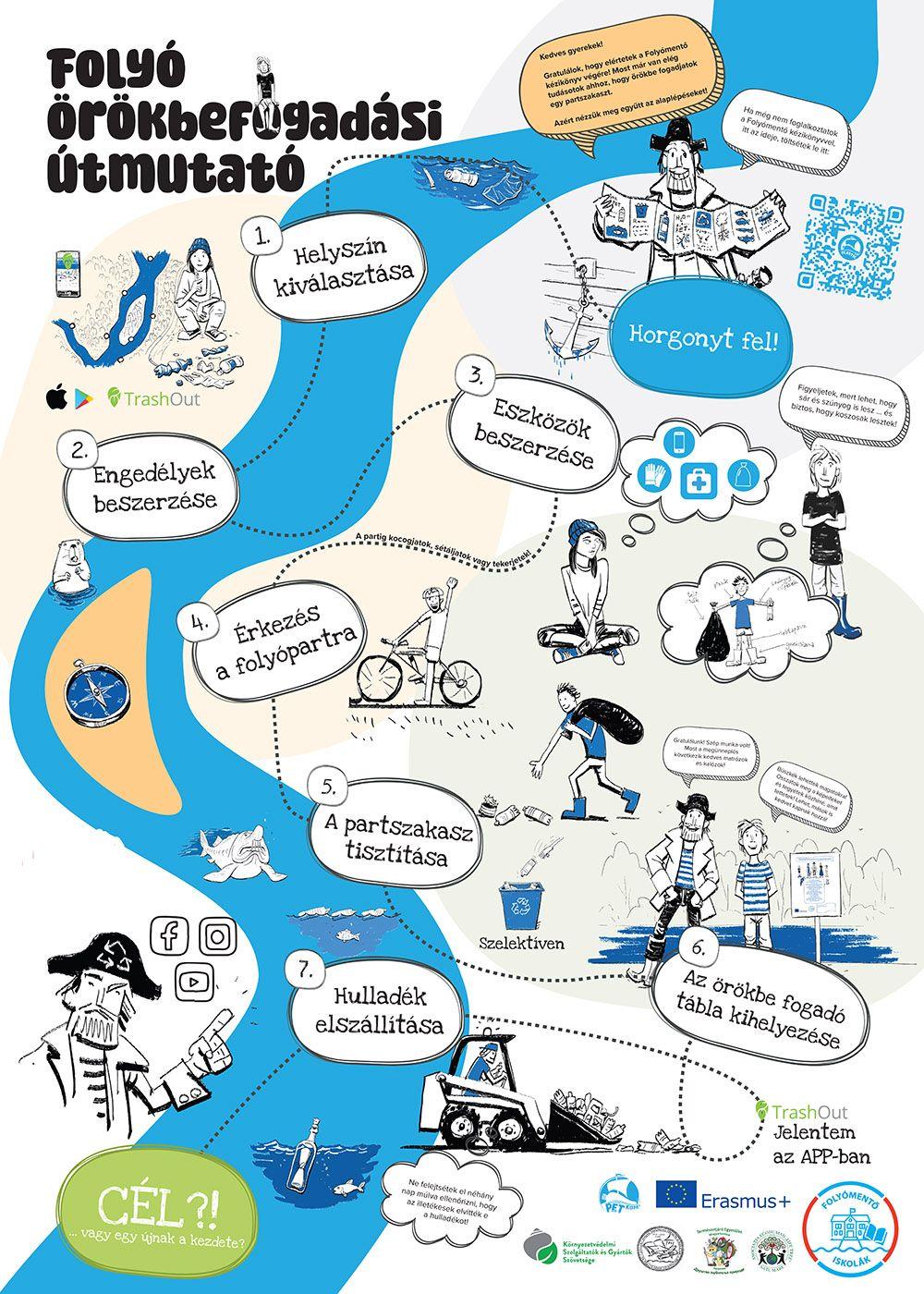Adopt a river!
How can you adopt a riverbank section?

A few years ago, under the auspices of the Pet Kupa, teachers and nature conservation associations from schools along the Tisza River joined forces to clean the river. Students were also involved in the work, adopting and taking care of several riverbank sections, which they continue to maintain to this day.
As a continuation of this initiative, the River-Saving Schools Erasmus+ Program was established.
- If you understand how much our daily lives depend on water and how vital it is;
- if you can tolerate billions of mosquitoes and don’t mind getting dirty (your shoes, clothes, everything);
- if you have seen waste floating on water;
- and if you are willing to do something about it, then join this program!
River Adoption Protocol
Steps to Adopt a Riverbank / Activities
1. Selecting a Location
What can the teacher do?
- Prioritize children’s safety when choosing a suitable location.
- Opt for an accessible section of the riverbank, preferably close to the school to minimize travel time.
- Familiarize yourself with the terrain to ensure safe waste collection.
- Select a section that is relatively easy and safe to explore.
- The location should ideally be within walking or cycling distance from the school.
- Ensure the area is free of illegal dumpsites (which require professional cleaning), animal carcasses, or signs of substance abuse.
What can the students do?
- Students can assist in choosing the location.
- It’s beneficial to select a site they are connected to, such as places they cycle by or go fishing.
- Students can also perform online waste monitoring:
- Use the TrashOut app for waste monitoring (requires a mobile phone and internet).
- Map polluted areas and record them on an online map, marking the type and amount of waste and indicating if the area has been cleaned.
Learn more about TrashOut through this video tutorial.
https://www.youtube.com/watch?v=yd9IBX5LDqk
https://www.youtube.com/watch?v=tQ0xIMz4DBE
2. Obtaining Permissions
What can the teacher do?
- Obtain the necessary local permits for both the cleanup and placing the adoption plaque.
- Notify and request approval from the relevant authority (e.g., local municipality, nature conservation officers, or river management authorities).
- Obtain parental consent for taking and publishing photos and videos of children during the program.
3. Procuring Equipment
What can the teacher do?
- Provide waste bags, protective gloves, and plenty of enthusiasm!
- Advise children to dress appropriately for the weather and to bring mosquito and tick repellent, sunscreen if needed, and a water bottle.
- Avoid bringing food unless proper handwashing facilities are available.
What can the students do?
- Wear appropriate clothing: long-sleeved tops, long pants, and waterproof, comfortable shoes.
- Bright colors or easily noticeable accessories like caps or shirts are recommended.
- Bring essentials like water, tissues, and hand sanitizer.
https://photos.app.goo.gl/5LECa7y6Ro4EEixR8
https://photos.app.goo.gl/g94epuKcHqoGRRDw6
https://photos.app.goo.gl/3MzRAbga5ZtqkiPq8
https://photos.app.goo.gl/n3yWuUhwcTc3ZD267
https://photos.app.goo.gl/iW5iNKRc82QFYQXs6
https://photos.app.goo.gl/weV74y9eUPiDEeCx7
4. Arrival at the Site
- Whenever possible, arrive on foot or by bicycle to minimize environmental impact.
5. Cleaning the Riverbank
What can the teacher do?
- Discuss basic behavioral norms: avoid disturbing or damaging the natural environment and ensure safety.
What can the students do?
- Work in pairs and use gloves to collect waste, adhering to safety guidelines.
- Only pick up non-hazardous river waste—avoid sharp, infectious, or dangerous items (e.g., broken glass, syringes, animal carcasses).
- Take photos or videos during the cleanup.
https://www.youtube.com/watch?v=XkwUzvrrxXU
6. Installing the Adoption Plaque
What can the teacher do?
- Prepare the plaque with standardized text (downloadable from a provided link) before the cleanup.
- Place the plaque according to local conditions.
What can the students do?
- Collaborate in installing the plaque and celebrate the event.
https://www.youtube.com/watch?v=bj0FxdvF6V0
https://www.youtube.com/watch?v=E7qLKZsVIKE
https://www.youtube.com/watch?v=OEc6ukHFqqI
https://www.youtube.com/watch?v=bj0FxdvF6V0&t=3s
7. Waste Removal
What can the teacher do?
- Arrange for the collected waste to be removed by contacting local waste management services beforehand.
What can the students do?
- Ensure no waste is left behind. Document the cleanup in the TrashOut app.
https://www.youtube.com/watch?v=iJas0Skd28I
8. Organizing Programs at the Adopted Riverbank
- Use the adopted site for school programs or environmental awareness days.
- Regularly revisit and maintain the site.
9. Promoting the Initiative
What can the teacher do?
- Write reports and involve media outlets to share the program’s results.
What can the students do?
- Share photos and videos on social media and talk about the initiative with family and friends.